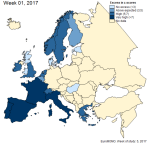Those of you who have spent any time debating or discussing the current coronavirus “pandemic” on social media will almost certainly have encountered an argument that goes something like this:
“Coronavirus is nothing like the flu, the seasonal flu doesn’t overwhelm health services like this.”
But is this true? We’ve done some research.
In 2018 hospitals all
across the United States were full to capacity with flu patients. Alabama declared a
state of emergency. Elective surgeries were cancelled,
patients were turned away.
California hospitals were “war zones” where people were treated in
hastily erected tents.
The same year ICUs in Milan were
“totally overrun” with flu cases.
In December of 2019 the NHS had to implement “emergency temporary beds” in 52% of its hospitals to account for their
regular “winter crisis”. Most of those hospitals still had temporary beds operating
from the previous winter.
Last November experts were publishing reports warning that the NHS was under
too much pressure to deal with the seasonal flu.
The 2009 Swine Flu pandemic turned out to be no worse than a bad flu season in the end, but nevertheless had
a huge impact on hospitals across the United States.
...rest at site:
https://off-guardian.org/2020/04/02/coronavirus-fact-check-1-flu-doesnt-overwhelm-our-hospitals/

